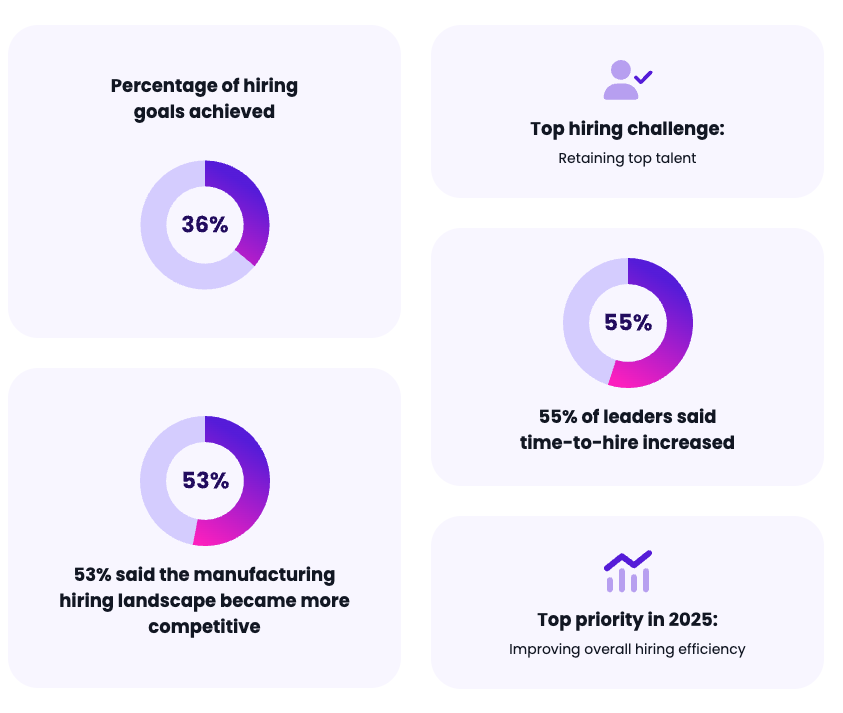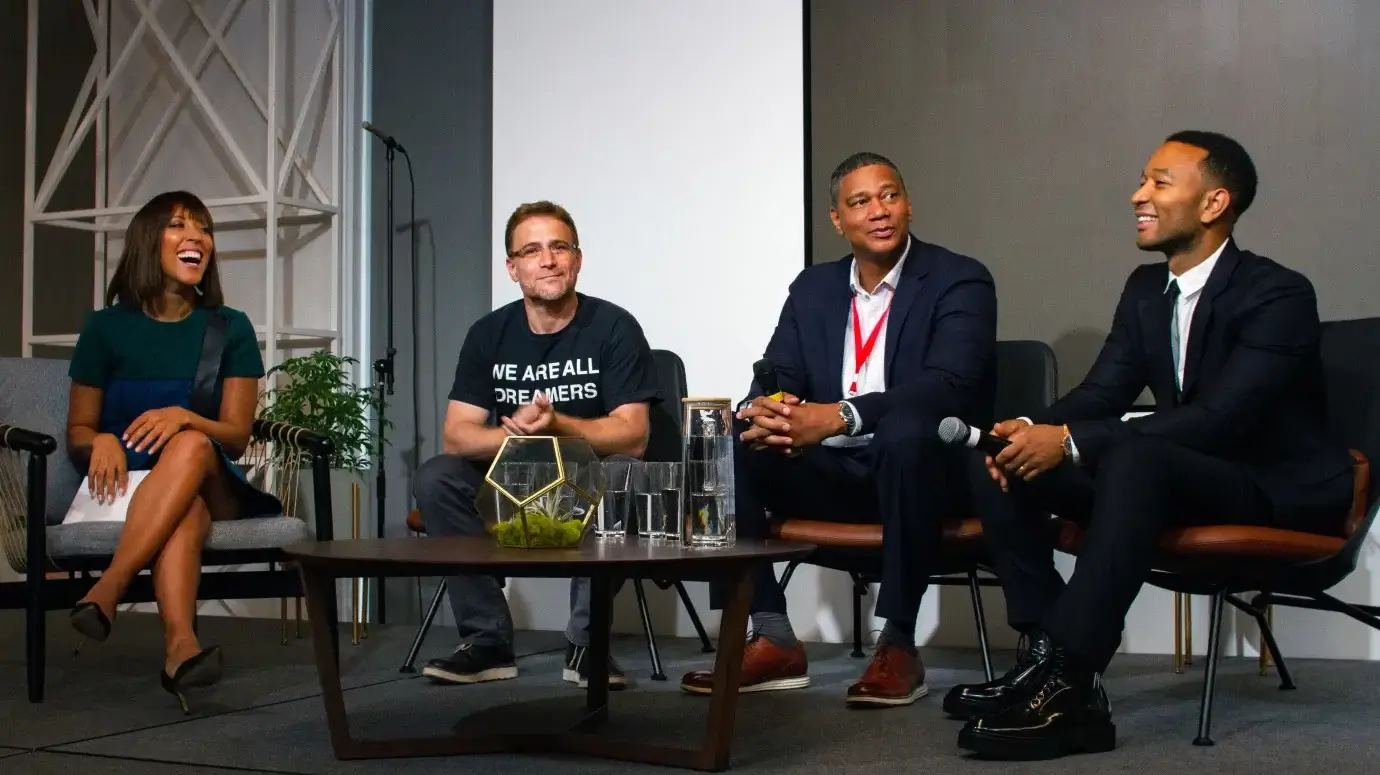Editor’s note: The article below is an excerpt from GoodTime’s 2025 Hiring Insights Report. The entire report is available to view online for free here.
In the last year, manufacturing recruiting faced unprecedented challenges as labor shortages and increasing competition for skilled workers disrupted the sector. Manufacturing’s talent acquisition (TA) leaders struggled to fill roles amid high turnover rates, misaligned candidate qualifications, and unmanageable workloads for recruiting teams. These challenges, compounded by slow hiring processes and poor candidate engagement, threatened operational stability in an industry heavily reliant on a consistent workforce. As a result, manufacturing hiring teams were forced to rethink their strategies and find innovative ways to adapt to shifting workforce dynamics.
This section of our 2025 Hiring Insights report explores the key trends, challenges, and strategies that defined manufacturing hiring over the last year and previews how the sector is preparing for 2025. From leveraging automation and AI to streamline workflows to prioritizing personalization and transparency to better engage candidates, manufacturing organizations are beginning to lay the groundwork for a more agile and competitive hiring approach. As TA leaders prepare for another demanding year, the insights and strategies highlighted here provide a roadmap for navigating a complex and evolving labor market.

Unlock manufacturing’s top hiring strategies in 2024
Our study of 105 manufacturing TA leaders reveals how to hit your hiring goals in a challenging market.

Executive summary: Key manufacturing recruiting trends

- Percentage of hiring goals achieved: 36%
- Top hiring challenge: Retaining top talent
- 55% of leaders said time-to-hire increased
- 53% said the manufacturing hiring landscape became more competitive
- Top priority in 2025: Improving overall hiring efficiency
Looking back at 2024: Manufacturing recruitment faces mounting hiring challenges
In 2024, manufacturing hiring teams struggled to meet workforce demands, achieving only 36% of their hiring goals—a significant decline from 44% in both 2022 and 2023 and by far, the lowest of all sectors surveyed.
Manufacturing hiring teams faced significant workforce challenges in 2024, with retention, recruiter capacity, and candidate reliability emerging as top concerns. High turnover continued to disrupt staffing stability as workers sought better pay and benefits in other industries, while unmanageable workloads for recruiting teams further strained hiring efforts.
A standout challenge was the increasing frequency of new hire no-shows. Despite receiving offers, candidates often failed to show up for their first day, creating last-minute staffing gaps that delayed productivity and forced teams to restart the hiring process. This trend points to a growing need for stronger candidate engagement and clearer pre-boarding strategies to secure commitment after offer acceptance.
Additionally, the complexities of hybrid work models, evolving hiring policies, and the challenge of balancing a large applicant pool with qualification mismatches further extended hiring cycles. These trends underscore the importance of refining hiring processes to prioritize candidate commitment, recruiter efficiency, and long-term workforce stability in the manufacturing sector.
Hiring bottlenecks compound manufacturing’s labor shortage challenges
In 2024, 55% of manufacturing organizations reported an increase in time-to-hire, emphasizing the sector’s ongoing struggle to fill roles efficiently amidst a widespread labor shortage. Only 2% of respondents reported improvements in hiring speed, while 43% saw no change, surfacing the difficulty of reducing time-to-hire in the sector.
“I think AI will increase the speed of recruitment, but also it’s going to help us to better match skills with how the company wants to hire. It’s a great opportunity for us to increase the productivity of our teams.”
-Nikola Dimov, Global Head of Talent Acquisition, AkzoNobel
Manufacturing hiring teams faced significant bottlenecks in 2024, with communication gaps, limited interviewer availability, and decision-making delays emerging as major disruptors. Poor communication with candidates and delayed responses from hiring managers not only slowed hiring timelines but also risked losing top talent mid-process.
Compounding these issues were capacity constraints, with a limited pool of interviewers and frequent interview cancellations creating scheduling challenges. Additionally, a shortage of qualified candidates and candidate withdrawals further strained hiring efficiency, emphasizing the need for process improvements and stronger engagement strategies to reduce drop-off rates and accelerate decision-making.
The manufacturing hiring landscape showed mixed dynamics in 2024. While 53% of leaders reported that the sector became more competitive due to increased demand for talent, 47% noted the opposite—citing an increase in available talent. This apparent contradiction reflects differences across specialized labor needs, with some roles experiencing a talent surplus and others facing acute shortages.
Recruitment team turnover (42%) and rising dropout rates among candidates (35%) added to the sector’s challenges, complicating efforts to maintain hiring momentum. At the same time, 36% of respondents emphasized the growing importance of creating meaningful candidate relationships, while 35% pointed to the increasing touchpoints required to engage candidates effectively. These changes underscore the evolving expectations of both employers and job seekers in the manufacturing industry.
For hiring leaders, navigating this nuanced landscape requires flexibility and targeted strategies. Whether addressing specialized talent shortages or leveraging available labor pools, organizations must refine their processes to adapt to shifting market conditions and meet both immediate and long-term workforce needs.
How manufacturing addressed hiring challenges in 2024
Manufacturing organizations in 2024 took key steps to address hiring challenges, focusing on personalization, efficiency, and technology upgrades. Many teams emphasized improving the candidate experience, recognizing that stronger early engagement can lead to better offer acceptance and retention.
The focus on faster time-to-hire reflects the urgency to fill high-volume roles while minimizing staffing gaps. At the same time, increasing investments in hiring technology and automation signal a shift away from manual processes, with teams looking to streamline scheduling and reduce recruiter workloads.
These trends highlight a shift toward balancing speed, engagement, and operational efficiency—though challenges like candidate no-shows and drop-off continue to impact hiring outcomes.
Automation and AI adoption have played a growing role in streamlining hiring tasks across manufacturing teams, with the heaviest focus on interview scheduler tools, content generation, and reporting. Many teams have embraced AI-driven tools like chatbots and resume screening to alleviate repetitive tasks, allowing recruiters to focus on more strategic work.
However, adoption remains uneven. While tasks like scheduling saw significant automation, areas like interview analysis continue to lag, suggesting room for improvement in how data-driven insights are used to refine hiring decisions. As AI tools evolve, manufacturers have a clear opportunity to expand their use of automation for both efficiency and smarter decision-making.
Hiring automation built for manufacturing
Re-ignite your interview process and schedule candidates up to 67% faster.

Building a fast and simple recruiting process for candidates
In 2024, manufacturing organizations emphasized scheduling efficiency as a key priority to improve the candidate experience and accelerate hiring timelines. Features like the ability for candidates to reschedule interviews automatically through a platform (51%) and automated scheduling at their convenience (50%) topped the list of improvements. These tools not only reduced delays but also enhanced flexibility, making the hiring process more candidate-friendly.
How manufacturing hiring teams measure success
Manufacturing teams are focused on a blend of candidate experience and operational efficiency recruitment metrics to measure hiring success. Candidate interview experience topped the list, underscoring a heightened awareness of how positive interactions during the hiring process impact talent attraction. Similarly, metrics like time-to-hire and offer acceptance rate remain priorities, reflecting the sector’s ongoing pressure to secure candidates quickly in a competitive labor market.
At the same time, continued emphasis on quality of hire and diversity tracking suggests a balanced focus on both long-term employee success and inclusivity. However, lower measurement of early funnel metrics, such as application completion rates, indicates room for improvement in understanding candidate drop-off points and optimizing the early stages of the hiring process.
How manufacturing talent leaders are gearing up for 2025
As manufacturing talent leaders look to 2025, recruitment team turnover (53%) is expected to be the biggest disruptor, further straining the ability to manage candidate flow effectively.
Additionally, 40% anticipate increased competition for talent, while 39% expect higher dropout rates among candidates—further complicating efforts to meet hiring goals. At the same time, 38% believe the hiring landscape will become less competitive due to an increase in available talent, signaling mixed perspectives based on regional or role-specific dynamics.
Looking ahead to 2025, manufacturing leaders anticipate a diverse range of hiring challenges, with hybrid work complexities, shifting company policies, and candidate misrepresentation via AI among the top concerns. The growing presence of hybrid work environments continues to create logistical hurdles for both interview scheduling and role adaptation, while evolving policies signal increased compliance and structural shifts within organizations.
To address these challenges, manufacturing leaders must focus on improving agility, investing in technology, and fostering stronger candidate relationships. These strategies will be critical for overcoming recruitment bottlenecks and maintaining competitiveness in a sector marked by fluctuating labor dynamics
Manufacturing leaders shift strategies in 2025
Manufacturing leaders are prioritizing efficiency and personalization as they refine their hiring strategies for 2025. Improving overall efficiency (40%) tops the list, a strategic response to the unmanageable workloads reported as a top challenge in the previous year. This focus suggests a direct effort to ease recruiter strain by streamlining processes and reducing manual tasks.
Other priorities include increasing personalization throughout the hiring process (36%) and upgrading hiring technology (32%), underscoring the sector’s intent to modernize operations while maintaining a focus on candidate engagement.
Automation and technology will play a central role, with 96% of leaders indicating they are likely or very likely to invest in tools that optimize hiring workflows (31%) and leverage AI for greater efficiency (25%). Improving offer acceptance rates, standardizing processes, and enhancing the candidate experience also remain key areas of focus.
“Where we need to attract a lot of talent, in my case, for manufacturing, AI is a very great tool. We are already seeing costs and labor times going down, and actually the desired outcome is very high. So I’m very excited about AI helping us.”
-Frank Peeters, Manager Talent Acquisition Europe, Lucid Motors
By aligning investments with strategies that prioritize speed, personalization, and engagement, manufacturing organizations are positioning themselves to navigate labor market challenges while building a more resilient talent acquisition approach.
Final thoughts and key takeaways
This year, manufacturing hiring teams faced significant challenges, including persistent labor shortages, extended time-to-hire, and inefficiencies in processes. The sector struggled to achieve hiring goals, with issues like unmanageable workloads for recruitment teams, candidate dropouts, and poor communication creating bottlenecks. Despite these hurdles, manufacturing organizations began leveraging automation, AI, and streamlined workflows to improve hiring outcomes and better engage candidates.
Looking ahead to 2025, manufacturing leaders should prioritize:
- Investing in hiring technology: Upgrading tools to optimize scheduling, streamline workflows, and automate repetitive tasks will be essential for reducing time-to-hire and improving efficiency in a labor-constrained market.
- Enhancing candidate engagement: Personalization, transparency, and fast hiring processes will help organizations stand out in a competitive talent landscape and increase offer acceptance rates.
- Strengthening recruitment team capacity: Providing training for hiring managers and interviewers, while leveraging automation to reduce administrative burdens, can ease workloads and improve hiring efficiency.
- Focusing on actionable metrics: Expanding the measurement of candidate experience alongside operational metrics like time-to-hire will provide valuable insights for refining processes and improving outcomes.
By addressing these areas, manufacturing organizations can adapt to a challenging labor market, attract skilled talent, and build a more sustainable approach to hiring in 2025.




